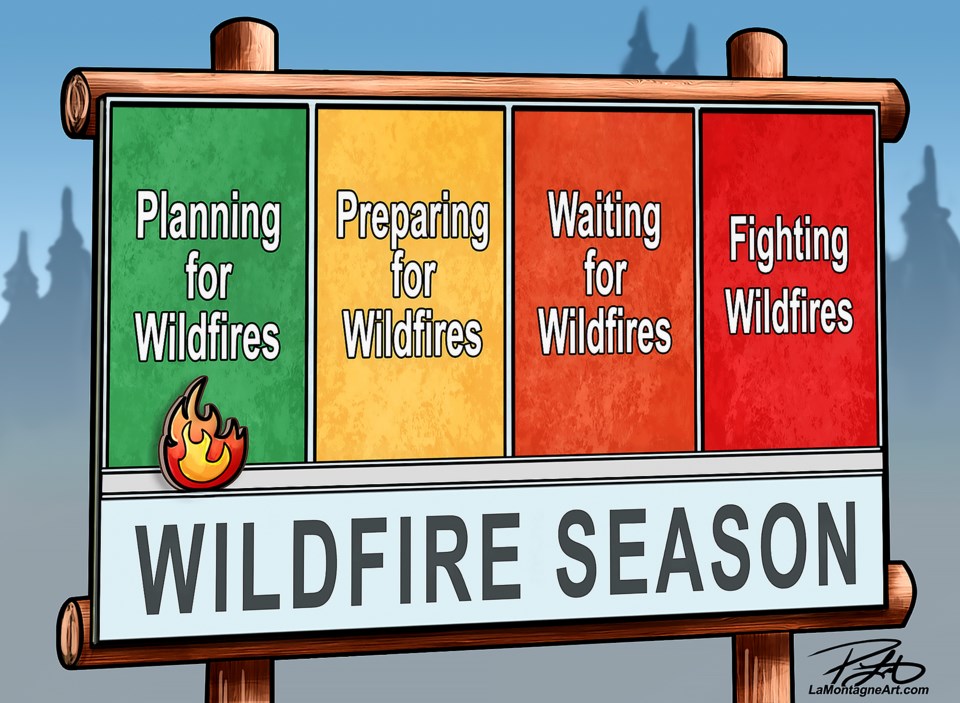A traditional Bow Valley April can bring many things to the area.
A fresh blanket of snow, the gradual increase in tourism and the official return of wildfire season.
Despite weather suggesting the contrary, wildfire season has returned to the province, taking up the better part of the year running from March 1 to Oct. 31. While snow can linger well into May and make periodic appearances any other day of the year, the hot spots for potential fire dangers are around the corner.
During this time, the dry spring and summer weather can lead to skies filled with smoke, water bombers in the air and coughing as if they’ve crushed a few packs of cigarettes because of the smoke.
But as cliché as it is, it’s ultimately up to each person – resident and visitor – to take responsibility to prevent a worst case scenario with wildfires.
Last year, 1,246 wildfires burned a combined total of 130,000 hectares of forest. The bulk of them – 61 per cent – were human-caused, with 38 per cent from lightning and one per cent remaining under investigation.
According to Alberta Wildfire, 218 wildfires were caused through recreation and another 161 were by residents.
The leading cause of detection, by a long shot, was members of the public, who called in 581 of the wildfires, followed by 288 reported from lookout towers.
Though most of Alberta’s wildfires take place in sparsely populated areas north of Edmonton, it doesn’t lessen the threat to areas such as the Bow Valley.
With nature playing a preeminent role in the region and millions of people visiting each year, the reality is it could take very little to cause a disaster.
A pair of wildfires to the east of Canmore in 2021 had the area on alert. One near Lac Des Arcs burned 4.4 hectares of forest, while another close to Dead Man’s Flats consumed roughly six hectares.
In the case of the Lac Des Arcs wildfire, a cigarette butt tossed out a passing car window on the Trans-Canada Highway was deemed to be the cause, highlighting the relative ease in igniting the heavily forested area.
The evacuation of Fort McMurray in 2016 remains fresh in the minds of all people in Alberta. Though it’s unlikely to happen on such a large and similar scale, it doesn’t lessen the need to prepare.
The Verdant wildfire in 2017 in Kootenay National Park burned more than 18,000 hectares in two months and led to evacuations of areas such as Sunshine Village.
The Devil’s Head wildfire in 2020 destroyed 2,420 hectares of forest, putting the MD of Bighorn on notice to evacuate. It was sparked by an abandoned campfire.
Outside of people using common sense, prescribed burns are among the best defence in preventative measures. The region has several set to begin or already underway such as in the area of Ribbon Creek by Kananaskis Village in Kananaskis Country.
Parks Canada will also work on numerous areas in Banff, Jasper, Kootenay, Waterton and Yoho national parks. The prescribed burns can vary from as little as 1.8 hectares to the nearly 4,500 hectare area along the Fairholme benchlands.
Prescribed burns are essential in helping to create diversity in vegetation, but also reducing the risk to communities. With the growing risk of climate change, the reality is without such burns the risk of wildfire will only grow.
The risk of wildfires is always present, but with the threat of climate change actively increasing – research from the United Nation’s Intergovernmental Panel on Climate Change shows the earth is warmer than at any period in the last 125,000 years – the reality is the danger will only grow.




